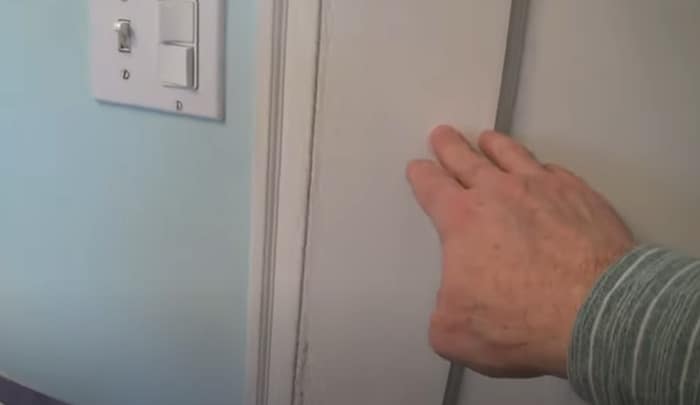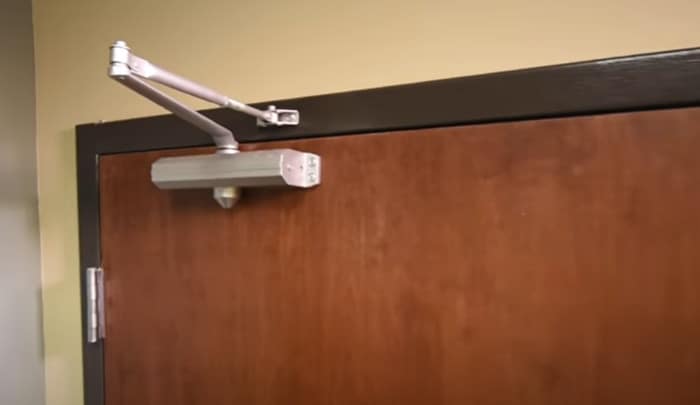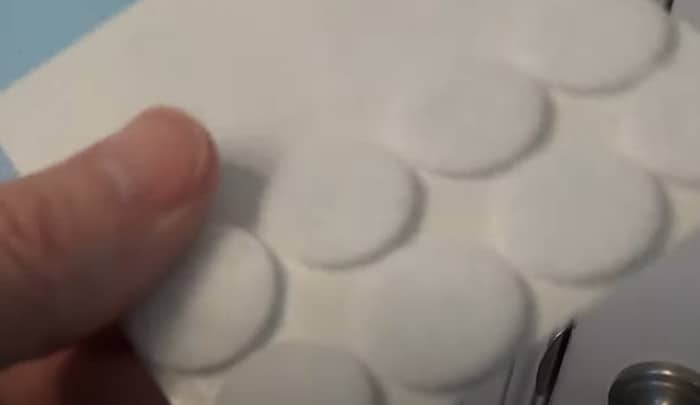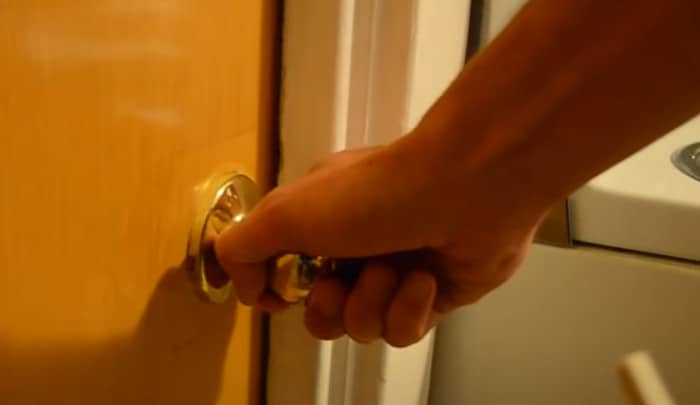For years, many people have had the same frustrating experience with a door in their house that just won’t seem to stay shut. It’s not just an annoyance; it’s an out and out mystery. Why is it that this one door, that everyone in the family uses all the time, keeps slamming shut no matter what anyone does? This persistent issue can be both irritating and potentially damaging to your home? Is it the wind, a draft, an evil spirit, or could something else be causing the problem? Well, let’s open the door and get to the bottom of this mysterious slamming sound once and for all.
Installing a pneumatic door closer is an easy and effective way to stop your door from slamming shut. You can also adjust the existing door hinges or use an automatic open-and-close latch to keep it from swinging too hard and causing it to slam.
“Most cases of doors slamming shut without any apparent reason can be attributed to pressure differentials within the building. This can be especially prevalent in modern constructions with efficient, tight-sealing windows and doors since the pathways for natural air flow around the house are lessened. It’s quite like the concept of a draughty old house in reverse. It’s critical to ensure good ventilation in the property to eliminate such problems.”
Percival O’Sullivan, Building Consultant
What Causes Door Slamming Shut
The mysterious and often aggravating occurrence of doors slamming shut is a phenomenon that has plagued homeowners for years. There are two primary theories as to what causes the door to slam shut: faulty mechanics or air pressure.
Those who subscribe to the faulty mechanics explanation attribute the random door slams to either a bad latch or door hinge. These parts can occasionally become misaligned thus resulting in the latch or hinges not properly holding the door closed so that when gusts of wind come through, they sufficiently push on it to cause a closure. Ultimately, this theory blames the structure of the door rather than outside forces.
When it comes to air pressure, many believe that when high-velocity winds come into contact with an open door, it will cause the door to close due to changes in atmospheric pressure. In short, this means that as air comes through an opening, new air rushes quickly in and causes the existing air within an environment to move out quickly and press against the opened doorway in turn pushing it closed.
Ultimately, both theories have their merits and could technically be seen as occurring at the same time. That being said, much like any mystery there are many potential solutions and attempts available and it’s worth exploring them all. After all, understanding the root cause(s) is only half of the battle – knowing how to prevent a door from slamming shut is just as important! The following section will discuss how to prevent future occurrences of door slamming shut.

Essential Points
Doors can slam shut due to misalignment of its components or air pressure caused by gusts of wind. To prevent future occurrences of door slamming, homeowners should investigate the cause and find a suitable solution. Ultimately, understanding the root cause(s) is just as important as knowing how to stop it from happening in the first place.
How to Prevent Door Slamming Shut
In order to prevent door slamming shut, there are a few different methods to explore. Some methods provide more extensive solutions while others simply maintain the same problem but in a marginally better state. It is up to the homeowner to decide which approach works best for their door situation, and what fits within their budget, if needed.
One of the most effective solutions for preventing doors from slamming shut is installing a door closer. Door closers work by automatically closing the door after someone walks through it, making sure that it reaches a set point before releasing it. This not only prevents slamming but also helps maintain a consistent indoor environment, making sure that it reaches a set point before releasing it. Door closers come in spring or hydraulic form and can be used in both residential and commercial settings. With these devices installed, homeowners can rest assured that the door will be securely closed and avoid any unnecessary noise or disruption.
On the other hand, some may argue that this detracts from a traditional aesthetic, or requires too much of an installation project for their taste. Homeowners can instead opt for lighter solutions such as adding hinge pins and soft-close inserts to ensure the gradual closure of their doors. This method often yields similar results but on a smaller budget, and without any physical changes to the door itself.
No matter what option they choose, homeowners do have options available when it comes to stopping a door from slamming shut. By making minor adjustments such as using a door closer or adding soft-closing inserts, homeowners can reduce disruptions and restore peace of mind in their home environment. Before moving onto those minor adjustments however, be sure to investigate all possibilities to find what solution works best given home’s individual needs. And with that in mind, let’s move onto the next section about: Minor Adjustments

Minor Adjustments
Making minor adjustments to the door and frame can often be an effective method for stopping a loose door from slamming shut. Specifically, tightening any screws that attach the hinges to the door frame, or adjusting the hinges by carefully tapping them in or out with a hammer and wood block can help alleviate this issue. Additionally, adding a door closer can help keep a door from slamming shut. Door closers are automatic spring-loaded latches that use hydraulic pressure to close a door slowly and smoothy after it has been opened.
Many homeowners argue these methods may not be enough to solve the problem of a slamming door if it is caused by something other than an ill-fitting door or poorly installed hinges. If the problem is caused by air drafts, these minor adjustments won’t completely solve this issue. Furthermore, if the door is too heavy or otherwise unbalanced, even adding a door closer will only offer temporary relief as the weight of the door will quickly break or wear out any mechanism meant to slow its movement.
On the other hand, advocates of making minor adjustments suggest that such measures will help regardless of whether poor construction or environmental factors are causing the problem. For example, they argue that replacing screws into pre-drilled holes on a hinge may improve how snugly they fit into the frame, reducing shaking and bouncing caused by the constant opening and closing of the door which may contribute to it suddenly swinging open and then slamming shut. In either case, making minor adjustments should always be undertaken first before moving onto more extreme measures like DIY noise prevention.
In this section we discussed potential solutions for solving loose doors that tend to slam shut derived from making small yet significant adjustments to both the door itself as well as its frame. Some argue such measures will be useless against environmental factors while others claim they are useful despite external influences like drafts. In either case, making minimal changes should always be attempted first before tackling bigger projects like DIY noise prevention. The following section will explore how homeowners can construct their own soundproofing materials to make sure their slamming doors stay shut regardless of their reasoning behind them.
- According to a study published in 2014, the average rate of home air infiltration from doors being left open is 18.3 m3 per hour per door.
- The same study found that energy losses from leaves and entry doors can range from 15%-30% of total heating and cooling loads for residential buildings.
- Additionally, depending on the type of door used, noise levels associated with slamming doors vary. A 2013 study found that relative sound pressure levels (SPL) can range between 40 dB to 125 dB when using standard wooden interior doors.
DIY Noise Prevention
DIY Noise Prevention is one way to solve the mystery of a door that keeps slamming shut. It involves adding materials and pieces around the door frame to dampen the noise created when it slams. Rubber bumpers, weatherstripping, decorative metal strips, and other types of soundproofing materials can be applied to the door or frame to reduce or stop the loud sound altogether. This approach can significantly improve your home’s acoustics and overall comfort.
This approach may not be the most aesthetically pleasing option and could even potentially block too much noise from passing through, but for homeowners faced with an incessant door-slamming pattern it could be an effective short-term solution until further repairs or replacements can be completed. Additionally, to further reduce sound levels, consider double-layer doors with a layer of air between each side that will capture sounds waves as it passes through.
For those who prefer their doors to remain soundless without obstructing any noise from entering or exiting, investing in attractive noise-canceling products such as hinges and wheels might be worth the cost. These specially designed and manufactured pieces are built with soundproofing techniques in mind and have become increasingly popular alternatives for reducing door noise.
The challenge lies in determining which approach is best for your particular situation. Both DIY noise prevention and investing in professional products require some form of investment if you want effective results. Ultimately it’s up to you to decide which solution best fits your needs and budget.
Now that we have discussed DIY options for preventing door slamming noises, let’s move on to the next step: How to Repair and Replace The Hinge and Handle.

How to Repair and Replace The Hinge and Handle
Solving the Mystery of the Door That Keeps Slamming Shut: How to Repair and Replace The Hinge and Handle In order to repair or replace a door’s hinge and handle, it is important to identify the type and manufacturer of your door. This task should be part of your weekly home checklist to ensure all doors in your home are functioning properly
’s hinge and handle, it is important to identify the type and manufacturer of your door. Besides consulting the manufacturer’s instructions, many modern hinges are adjustable so they can fit doors that are outsized. If a door fails to move after adjusting, then it is likely not a problem with the hinges but instead caused by something blocking the door. To inspect if this is the case, remove all screws and carefully lift off the head piece. After checking for any obstructions, start to assemble it back together.
The handrail must also be checked for signs of damage such as cracks and splits in the plastic part of the handle. This could indicate there could be an issue with the security and overall strength of your door. All parts should be replaced with components found in international standards for safety and design.
When replacing components, all surfaces will have to be protected during installation work as seizes and corrosion can harm components on contact. Whether you choose galvanised steel or stainless steel hinges and handles largely depends upon where you live geographically and whether there is much moisture present in the environment from sea breezes or weather changes. All areas consisting of a high level of saltwater require anticorrosive material suitable for marine environments.
On one hand, repairing or replacing parts can help reduce daily wear-and-tear on a door but on the other hand, over time these same parts will eventually require more significant repairs or eventually need replacing due to aging over time. As this can become a potential cost burden when done repetitively in a short amount of time; professional soundproofing solutions may provide better long term results without having to continually invest in repairs.
Now let’s explore professional soundproofing solutions as another option for securing a slamming door shut permanently.
Professional Soundproofing Solutions
The soundproofing solutions to address the issue of a door slamming shut vary depending on several factors, including the material of the door, the amount of noise being produced by it, and the surrounding area. Although there are many DIY products available, professional soundproofing solutions may be necessary in order to truly resolve the problem.
One popular solution for soundproofing a door is using a door sweep. These flexible rubber extensions easily attach onto the bottom of your door and provide an extra cushioning when closing. This can minimize the impact made when closing and reduce the overall noise level significantly.
Adding acoustic insulation to both the interior and exterior of a door is another viable option for reducing sound vibration transmission. Insulation such as foam panels or commercial blocks can be used to absorb any incoming noises coming from outside and muffle knob rattling sounds associated with slamming doors.
In some cases, replacing an existing door with one made out of solid material is necessary for reducing noise levels as much as possible. Solid-core doors consist of multiple layers of different materials which naturally deaden sound from both sides and effectively inhibit sound from coming in or out. In this case, additional soundproofing techniques such as acoustic sealant strips should be applied around the frame to enhance further muffling abilities.
Do bear in mind that these solutions might not always be practical or affordable depending on your particular circumstances; however professional soundproofing services should be considered when all else fails for this sort of situation.
As mentioned before, in order to really pinpoint which solution is best suited for your home you will need to assess various factors such as location of the problem area, type of material used on the affected wall or door, size, accessibility etc. Professional evaluation may be necessary if you find yourself in doubt or overwhelmed by these details.
To conclude this section, professional soundproofing solutions are available that can help reduce outgoing loud noises coming from slamming doors. Next, let’s look at ways to draw a conclusion regarding all that has been discussed thus far…

Conclusion
The mystery of the door that keeps slamming shut is a very strange and perplexing phenomenon with many potential causes. A thorough inspection of the door frame, hinges, door mechanism and alignment are necessary to identify the exact source of the problem. This inspection should be part of your home preparation for long trips to ensure your house remains secure and undamaged while you’re away. Common causes such as misaligned frames, loose screws, worn out parts and incorrect installation can be easily addressed but more complex issues like air drafts or uneven floors require an in-depth analysis. In order to make sure the correct repair is made, it may be beneficial to call an experienced door technician.
Debate:
The debate surrounding the cause of this mystery arises from whether it is due to a mechanical flaw or external forces such as air drafts. On one hand, proponents suggest that the most likely explanation for slamming doors is due to mechanical problems with wear involving the door frame, hinges, or mechanism. On the other hand, opponents contend that drafts caused by outside sources are to blame. Ultimately, an inspection of all components coupled with an assessment of air draft sources will enable homeowners to identify and resolve the issue.
Common Questions and Responses
Could an improper installation be causing my door to slam shut?
Yes, an improper installation is one potential cause of a door that keeps slamming shut. Installers should take care to make sure the frame is level and aligned correctly, that the hinges and latch are installed properly and securely, that the strikeplate is adjusted correctly and that the door fits snugly in the frame. If any of these elements are off-center or damaged, it may cause the door to swing too freely and slam shut on its own. Additionally, if the door does not close tightly against the frame, air pressure from air vents, furnaces or window air conditioners may force it to slam shut as well.
What are the dangers of leaving a slamming door unchecked?
The dangers of leaving a door that keeps slamming shut unchecked is that it pose a risk to safety and security. For example, if the door leads to an area where there is valuable property or hazardous materials, the constant slamming could cause the door to become ineffective in protecting those items. Additionally, a slamming door can lead to noise disturbances and even potential structural damage over time due to vibrations caused by repetitive impacts. If left unchecked, these disturbances and vibrations can be amplified further, potentially leading to cracks in foundations, walls, or other structural components. Furthermore, depending on the location of the door – such as near a staircase – it could increase the risk of physical harm if people were to trip over or stumble into the door when attempting to close it.
Is there an easy way to stop my door from slamming shut?
Yes, there is an easy way to stop your door from slamming shut. One way is to install a soft-close device that dampens the movement of the door as it closes, slowing its speed so that it stops closed with no banging or slamming. You can also adjust the door hinges so that they are slightly loose, which will prevent the force of the closing door from causing it to bang shut. Lastly, you can add a small rubber bumper to the edge of the frame near where the latch meets the door, which will help dissipate its energy and slow down its speed when closing.





From personal experience, I can tell you that one effective measure of ensuring your door doesn’t slam shut is by adjusting the hinges, particularly if they’re loose. Using a hinge tightening kit or just employing some good old elbow grease can do wonders and save you a lot of frustration.
Chantel, I absolutely agree that loose hinges could be a culprit. Something I’ve noticed during my years as a carpenter is that often it’s a combination of issues involving both the door and the frame, such as misalignment or warping, that leads to such problems.
Indeed, Colette, multiple issues can simultaneously contribute to a door slamming shut, it’s not always one isolated problem.
You might want to look into adding some insulation strips between the door and frame; those can also help minimize the slamming.
Thaddeus, your point about the insulation reminds me of a case I had early in my career where a pesky door kept slamming despite all efforts. Turned out, the issue was around the hinges being ever so slightly off-kilter, which insulation strips could not fix.
Chapman, I encountered a similar issue. I found out that sometimes worn door jambs or hinges could be the culprit; regular maintenance checks on the door’s hardware solved it for me.
I’ve dealt with similar door mysteries in my own home. My kids have a habit of slamming doors, and it got to the point where it loosened the hinges enough to make the door swing shut on its own.